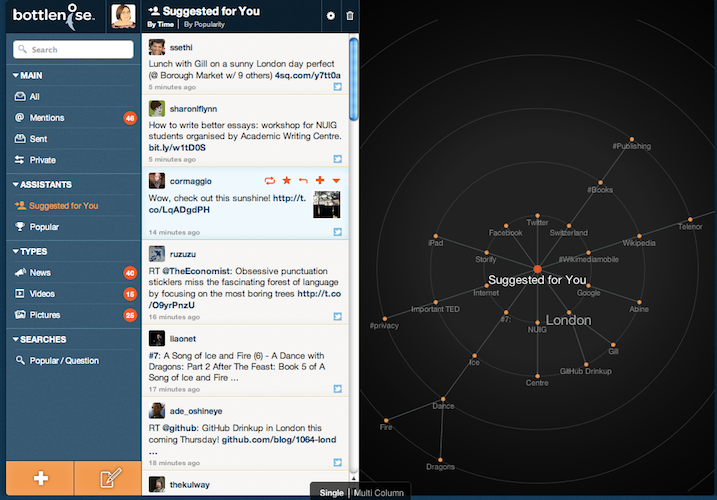A discussion of IRC in the classroom sent me off to my Zotero library for examples.
I remembered reading a few great papers on using IRC at conferences (these days twitter is the rage); what I didn’t remember was writing a mini-bibliography (shared below).
For teachers interested in using digital backchannels like IRC, IM, or twitter, the most pertinent is #6 below: Yardi, The role of the backchannel in collaborative learning environments. A new paper by graduate students at UBC is also worth a read: Nobarany, S., & Haraty, M. (2009 April 20). Supporting Classroom Discussions Using a Trust-enhanced Private Backchannel.” [author PDF] Proceedings of Human Interface Technologies 2008/9 Conference. Adding to the tools available, MIT media lab has a backchannel service, which they’ve written about [ACM copy].
UIUC’s LEEP program uses IRC as a backchannel in distance classes. (Though I hear they’re promoting verbal discussion with Elluminate this fall.) I found it very valuable to have private ‘whispers’ to classmates during our synchronous ‘live session’ classes. For me, it was also great to be able to type a question when I had it, without waiting for a pause in the audio lecture.
Originally written 2007-12-09 for GSLIS LIS 590IIL, Interfaces to Info Systems. Edited for links, formatting, and typos.
Digital backchannels refer to private communication between individuals also taking part in a public digital conversation. Whispers in live session are one example of a digital backchannel.
I reviewed 6 papers on “backchannels”, expanding outwards from 4 papers I found in CHI and CSCW proceedings. See the annotations in references below for more details about these papers. I recommend 2 papers. The seminal paper about digital backchannels, which I expect to become a classic in time, is Cogdill et. al. [1]. A briefer, but less meaty treatment, is given by McCarthy and boyd’s analysis of chatlogs from an in-person conference [2].
One caution is that, while linguists have studied “face-to-face oral backchannel for three decades” [1], studies in the digital realm are much newer, and “its spelling has not stabilized yet, so it can be found in all of its forms — backchannel, back-channel, and back channel — in current usage.”[1]. When researchers talk about digital backchannels, they sometimes seem to include private messaging between two individuals in the same sweep as group chats concurrent to some other activity. For example, Kellogg et. al. [3] discuss characteristics of backchannels which we’ll find familiar from LEEP classes—from the main room and private messages respectively: “They allow listeners to provide non-interruptive feedback to the speaker (‘raising hands,’ asking questions via IM), but at the same time they may take on the more private character of the second more political sense of backchannel (allowing two audience members to chat via IM with one another with no indication to others that it is occurring).”
Here’s a bit more detail about the papers I recommend:
Cogdil et. al. [1] present a taxonomy for backchannel communication. They “identified five backchannel categories: process-oriented, content-oriented, participation-enabling, tangential and independent backchannel.”
The CSCW ’04 conference had two events related to digital backchannels:
- a panel presentation about digital backchannels [4]
- an IRC chatroom for each of the conference’s three physical rooms
The chatrooms were logged for the duration of the conference, and McCarthy and boyd analyzed the chat logs[2]. (I wish I had a log of the chatroom from the panel session&emdash;talk about meta!)
McCarthy and boyd present two papers. One, coauthored with the panel presenters, is based on the panel presentation from CSCW [4]. It is their second paper—Digital backchannels in shared physical spaces: experiences at an academic conference [2]—that I find worthwhile. This paper organizes the backchannel IRC logs from CSCW ’04. With no apparent knowledge of Cogdil’s taxonomy, they provide concrete examples under their own rubric of “logistics, technology, people logistics, shared work, bonding”. These categories are overlapping with, but distinct from, Cogdil’s [1] conception. Additional discussion highlights social issues such as the privacy concerns of logging, the reactions of presenters, and the ingroup/outgroup concerns.
While these two papers [1] and [2] are the best of the lot, the others provide interesting context, because there are several sorts of research going on: pure sociological research (Cogdil [1]), social experiments (McCarthy and boyd [2]), educational research and experimentation ([6]), theoretical views on backchannels[4] , and commercial development projects ([3],[5]). (The last of these surprised me, but as Cogdil says, “Software designers can use these results to understand how the backchannel should function in digital conversation applications.” )
I think this variety is a microcosm of the sort of research presented in the ACM digital library. While browsing the suggested journals, I was especially struck by CHI, the JCDL, and CSCW. I downloaded papers on a variety of topics that seem within the province of librarians–even the traditional, non-digital sorts of librarians (perhaps I’ll write more about this sometime). I expected this in JCDL, since it is, of course, a joint conference, but I expected it less in the more mainstream ACM journals. Last semester, my IR class had an ongoing discussion about “what is information science” and where was the divide between computer science and library science, and library and information science. As UIUC embarks on the i-school movement with both ALA-accredited and non-ALA-accredited schools, I hope that this discussion of the relationship between information science and its sister fields will continue in larger forums, both within and outside of our classes.
From a usability perspective, I found it interesting that one paper explicitly referenced usability, while others talked of putting research into practice, tradeoffs, and trials.
And, before I sign-off, I’ll note 3 things that struck me particularly from Cogdill et. al. [1]:
“We also expect that participation-enabling backchannel takes place in asynchronous environments, but that it deals more with protocols such as how to subscribe and unsubscribe from the discussion.”-Cogdill et. al. [1] p7. I think they’re really underestimating this. I have off-list conversations about the listserv NGC4LIB and about the work of a journal committee quite regularly.
One disadvantage I’ve noted in the new style of private messaging in live session is the increased difficulty of self-archiving chats: “Users who want to preserve a backchannel conversation must do so for themselves, perhaps using their client software to capture a session log or pasting the contents of their backchannel exchanges into a text file. “Cogdill et. al. [1] p5. I’ve considered using my regular IRC software for live session, in part for its automatic logging capabilities. Of course, this still doesn’t address lining up conversations in-context.
Finally, Cogdill notes some disadvantages of the lack of awareness that one has about others’ whispers. In person, whispers may be observed even though their content is unknown. “If two students are silent on the mainchannel but active on the backchannel, the teacher may want to ask the students if they need assistance or need more time to accomplish some task.” Cogdill et. al. [1] p5
If you’ve made it this far, I’d be curious to know what you think.
smile -Jodi
[1] Cogdill, S., Fanderclai, T., Kilborn, J., & Williams, M. (2001). Backchannel: Whispering in Digital Conversation [Citeseer PDF]. Proceedings of the 34th Annual Hawaii International Conference on System Sciences (HICSS-34)-Volume 4 – Volume 4, 4033. doi: 10.1109/HICSS.2001.926500
Highly recommended (8 pages). Provides a “taxonomy of backchannel discourse”: process- oriented, content-oriented, participation-enabling, tangential, and independent backchannel.”, providing examples of each.
Describes various meanings of backchannel, notes that linguists have studied “face-to-face oral backchannel for three decades”, provides properties of “virtual backchannel” (private, multithreaded, and invisible). Their taxonomy was developed through analysis of “chat transcripts from several MUDs (text-based, persistent, user-extensible virtual environments). Thirty-six transcripts representing a total of 62 person hours of chat were studied”. Discusses possibilities for awareness and persistence of backchannels, and explains how this introduces self-censorship and group censorship. Typesetter’s errors in distinguishing italics from non-italics mar the presentation of the private/public distinctions in the chats analyzed.
[2] McCarthy, J. F., & boyd, D. M. (2005). Digital backchannels in shared physical spaces: experiences at an academic conference[author’s PDF]. CHI ’05 Extended Abstracts on Human Factors in Computing Systems, 1641-1644. doi: 10.1145/1056808.1056986 [ACM copy]
Highly recommended (4 pages). Provides a detailed analysis of the IRC channels used at CSCW 2004, including concrete examples of different types of exchanges. A bit different since it’s about supplementing in-person communication with digital backchannels.
[3] Kellogg, W. A., Erickson, T., Wolf, T. V., Levy, S., Christensen, J., Sussman, J., et al. (2006). Leveraging digital backchannels to enhance user experience in electronically mediated communication [Author PDF]. Proceedings of the 2006 20th Anniversary Conference on Computer Supported Cooperative Work, 451-454. doi: 10.1145/1180875.1180943 [ACM copy]
Discusses backchannels in the context of IBM VoIP conference call software which includes IM and visual backchannels.
[4] McCarthy, J. F., boyd, D., Churchill, E. F., Griswold, W. G., Lawley, E., & Zaner, M. (2004). Digital backchannels in shared physical spaces: attention, intention and contention [Author PDF]. Proceedings of the 2004 ACM conference on Computer Supported Cooperative Work, 550-553. doi: 10.1145/1031607.1031700 [ACM copy]
Notes from the panel held at CSCW 2004 on digital backchannels. Primarily records biographies and prepared statements of panel members. Data collected from the whole of this conference led to the analysis [2].
[5] Yankelovich, N., McGinn, J., Wessler, M., Kaplan, J., Provino, J., & Fox, H. (2005). Private communications in public meetings. CHI ’05 Extended Abstracts on Human Factors in Computing Systems, 1873-1876. doi: 10.1145/1056808.1057044 [ACM copy]
Discusses Sun Microsystems’ Meeting Central software, for distributed audio conferencing, which has private text and voice chats. Discusses usability testing, including screenshots of before and after designs.
[6] Yardi, S. (2006). The role of the backchannel in collaborative learning environments [Author PDF]. Proceedings of the 7th International Conference on Learning Sciences, 852-858. doi: 10.1145/1056808.1057044 [ACM copy]
“Students at UC Berkeley’s School of Information have participated in a persistent, online “backchannel” chatroom during class since the Fall of 2004.” Provides statistics about the chatroom usage, “indicating that a few users participate most often.” Posits the advantages as constructivist learning and peer-to-peer learning. Discusses the need for chatroom etiquette and the potential for distraction, as well as helpful inquiries.



